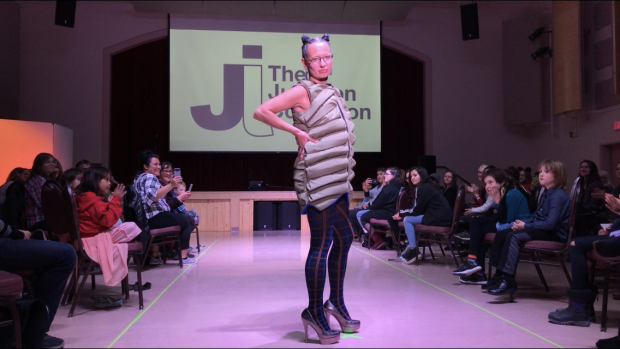Yukon village hits runway with help from Toronto fashion designer
Haines Junction, Yukon might not scream fashion hot spot like Paris or New York. But Saturday night, residents of the village took to the runway in designs specially made for them which reflect their community.
It was the culmination of the three-month 2018 Junction Artist in Residence program. The residency is held every other year. This is the second time it has been offered.
Toronto-based designer and artist Henry Navarro Delgado took on the residency's theme of "Sewing through the Landscape" with garments inspired by the lakes and trees surrounding Haines Junction, which sits at the edge of Kluane National Park.
"Walking around Kluane Lake I saw these sticks everywhere and it got me thinking about how the trees in the forest they are constantly fighting and constantly trying to move about and gain space," Navarro said.

Navarro Delgado created an upside down walking tree jumpsuit where the model's eyes are just visible above the tubular collar.
It's like a creature peeking out from the bottom of tree, he says.
Navarro Delgado says he's also inspired by the models themselves. Unlike other designers who might try to fit the garments to the model, Navarro Delgado says he makes the models a part of the design process from the beginning and tries to reflect them.
"Not only their physical beauty but also their psychological make up. How can I enhance that? How can I amplify what they're already bringing?," he said.

Navarro Delgado says he made a vest for model Monika Steputh because she often wears one, but it's unlike any other.
"I'm supposed to be a like a cabin. I'm home. I'm a shelter. It's very important to be this in a harsh environment where we're living in," said Steputh.
The log cabin vest even has a window cut into the back.
Steering clear of cultural appropriation
Navarro Delgado says he also found inspiration for this ten outfit collection in First Nations' philosophies, but says he avoided using Indigenous designs or motifs to not appropriate Indigenous culture.
Fashion shows can often be the setting for controversial intercultural expressions of art. In 2015, U.K.-based fashion label Konkon to Zai [KTZ] came under fire for a sweater that seemed to replicate a traditional Inuit shaman's jacket.
"I showed the sketches to elders before I started making the garments to get their feedback. I wanted to make sure that everything that I was doing was respectful and original work," Navarro Delgado said.
Still, one model says she felt some conflict about the outfit she was wearing.

Last year, Champagne and Aishihik First Nations citizen Amber Berard-Althouse, a member from the Wolf Clan, wore a black and red motorcycle-style jacket and pants that were inspired by a raven, which is similar to the identity of the Crow Clan.
In the clan system, it's against traditional law to wear symbols of other clans.
"It's actually a bit conflicting to tell you the truth. But I'm just honouring the raven and I feel if I embody that that's fine," she said.
Berard-Althouse says she consulted with her family and received their permission to wear the outfit.
Fashion and politics
Navarro Delgado is an associate professor at Ryerson University in Toronto. The university regards him as an expert in arts and fashion.
He says he's been interested in fashion as public art since he was a kid in Cuba.
"I went to boarding school and the uniforms were property of the state. So I altered the uniforms. My classmates saw that I could do that so they came to me and said, 'Hey, can you alter mine as well?". Then we got kicked out of class. So I saw that there was a power to this. There's a subversive aspect to this," he said.
Navarro Delgado hopes it's not the last time the collection is on show.
He's aiming to take the clothes to a catwalk in Toronto sometime next year.

